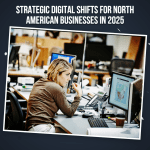Introduction: A Defining Shift in Search and Advertising
Google’s integration of advertising into its AI-driven search features marks a defining moment in the evolution of digital marketing. With ads now embedded in AI Overviews and AI Mode on desktop, the mechanics of how businesses reach customers have fundamentally changed. For small and medium enterprises in North America, this development is not a minor adjustment. It is a structural shift that requires a re-examination of advertising strategies, search optimization, and content planning.
Understanding the New AI Search Environment
In May 2025, Google expanded its Search and Shopping ads to appear inside AI Overviews. These AI-generated summaries sit prominently above traditional results. Additionally, Google’s AI Mode—designed to handle conversational, multi-step queries—now incorporates ads directly into the dialogue.
This transformation represents a departure from conventional keyword-based targeting. Advertisements are no longer matched solely to an individual query but instead respond to a broader range of contextual signals. User intent, sentiment, and the progression of a search conversation now determine ad relevance. The implication is clear: advertising has become integrated into the flow of the user’s engagement with information, creating new opportunities but also raising new complexities.
Opportunities for Businesses
Enhanced Visibility at the Exploratory Stage
One of the most significant benefits for small businesses is visibility earlier in the customer journey. For example, when users ask Google how to build a website for a small business with limited resources, relevant service providers may appear directly within the AI-generated summary. This positioning allows businesses to reach potential customers before purchase intent has fully formed.
Strengthened Authority Through Content
AI-driven search rewards authority and contextual expertise. Small businesses that invest in educational content, detailed guides, and thought leadership are more likely to be surfaced by Google’s AI. For advertisers, this reinforces the importance of maintaining a high standard of content quality. Ads supported by credible brand authority are positioned to achieve greater engagement within AI environments.
Early Data Suggests Competitive Engagement
Agencies report that impressions and top-of-funnel engagement from ads placed in AI contexts are at least comparable to, and in some cases exceed, traditional search benchmarks. Businesses with accurate product feeds, consistent updates, and polished creative assets appear better positioned to benefit from the new model.
Challenges and Emerging Risks
Decline in Click-Through Rates
Alongside new visibility, there are serious challenges. Multiple studies confirm that click-through rates decline sharply when AI Overviews are present. Position one results in traditional search can see CTRs fall by 15 to 35 percent, while organic listings may decline by more than 70 percent in some informational searches. Paid ads have also suffered, in some cases losing nearly half their CTR when paired with AI-generated results.
This development highlights a fundamental issue: impressions do not guarantee traffic. The user’s information needs are increasingly met within the AI Overview itself, producing a rise in “zero click” searches. Businesses that have historically relied on clicks for conversions face an urgent need to adapt.
Brand Safety and Transparency Concerns
Another critical issue is advertiser control. With limited insight into how and when ads are placed in AI summaries, concerns arise around brand safety and context. Advertisers also face a lack of transparent reporting, which complicates the evaluation of campaign performance. Without detailed feedback, optimizing for return on investment becomes considerably more difficult.
The Canadian Context
In Canada, the situation is particularly significant. Only 27 percent of Canadian small and medium enterprises currently report using AI. As Google expands its AI advertising integration northward, Canadian businesses must prepare to adapt quickly. Those with structured feeds, optimized Google Business Profiles, and localized SEO strategies will find themselves at a competitive advantage.
Best Practices for Businesses in the AI Era
Prioritize Structured Data and Feed Accuracy
AI-driven ad placements rely on structured and up-to-date information. Product feeds, business profiles, and creative assets must be consistent and well maintained to ensure eligibility for AI-driven visibility.
Elevate Authoritative Content
Businesses must prioritize authority-driven content strategies. Tutorials, white papers, and expert insights not only build trust but also align with the signals Google’s AI relies upon for contextual placements.
Invest in Local SEO
Local search remains a stable and critical channel. Queries for nearby services, such as plumbers or dentists, continue to deliver value with less interference from AI Overviews. Maintaining accurate location data and community-specific content remains vital.
Redefine Performance Metrics
Traditional measures such as CTR and CPC may lose some of their importance. Google has indicated that new models will focus on impression-based value and engagement within conversations. Businesses should begin monitoring long-term brand presence and recognition as indicators of effectiveness.
Diversify Beyond Google
Relying exclusively on Google in this new environment is not advisable. Businesses should explore alternative channels including social platforms, community-driven marketing, and other forms of digital engagement. Diversification reduces risk and builds resilience against fluctuations in Google’s AI model.
The Strategic Implications
The integration of advertising into AI search is not a temporary experiment. It represents a long-term change in the relationship between businesses, platforms, and consumers. The implications extend beyond technical adjustments in ad placement. They strike at the core of how authority is built, how brand presence is measured, and how businesses engage with audiences at scale.
Marketers and business leaders must respond with agility. Those who continue to approach search advertising with conventional metrics and methods will find themselves at a disadvantage. By contrast, organizations that embrace AI-driven discovery, invest in authoritative content, and monitor emerging forms of engagement will be positioned to secure competitive advantage.
An Authoritative New Landscape
Google’s decision to embed ads within AI-powered search reflects the growing centrality of artificial intelligence in shaping digital interactions. For businesses across North America, the shift underscores the need for strategic adaptation. Visibility is being redefined, metrics are evolving, and authority has become the currency of digital success.
Those who adapt quickly, invest in content quality, and diversify their marketing strategies will remain relevant in an ecosystem where AI-driven conversations are increasingly the gateway to consumer engagement. Those who hesitate may find that impressions are no longer enough to sustain growth in a world where clicks are no longer guaranteed.







